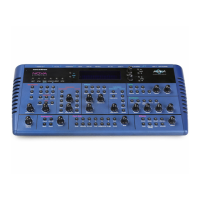As can be seen there are many peaks & they look like a “comb” hence the name Comb Filter. There are two parameters associat-
ed with this effect. Comb frequency controls the “frequencies” at which the peaks occur & Comb boost controls how high the peaks
are. The effect is to alter the timbre of the sound. Although similar to EQ, this effect can produce effects not possible using a stan-
dard EQ. The resulting sound tends to be quite “Metallic” sounding especially when large “Boosts” are applied.
Reverb.
This is an “Acoustic Simulation of a room. Why does singing sound good in the toilet? Reverb that’s why. The Reverb Effect is a
computer model of the acoustics of a room. The type of room is up to you, anywhere from the toilet to the local Concert hall is pos-
sible. Below is a simplified diagram of the reflections of sound in a room. Note there are many reflections from all directions.
When the Reverb button is pressed, the knob in the effect section controls how much Reverb there is. Anticlockwise there is little
effect. This can be thought of as being very close to the sound source within the hall. Fully clockwise there is lots & this can be
thought of as being at the other end of the hall from the sound source. Basically one way of looking at this parameter is “where you
are & where the sound source is in the hall”.
Different types of rooms & halls have different acoustics. For this reason Nova features several different Reverb types. These
range from very, very small rooms like the “Dry Chamber” setting to the very large hall like the “Large type 2” setting. Additionally
“special” types have been included. These are “Gated” types & are an artificial type of reverberation that sustains for a period &
then typically dies away suddenly rather than smoothly decaying away as reverb does naturally. These types can be used as a
special effect, especially on drums.
Most rooms have dominant large reflective surfaces ( Larger walls typically ) & these create dominant echoes in the reverberated
signal. Early ref ( reflection ) level simulates these reflections. Large amounts of Early ref level will produce strong signal at the
beginning of the reverb.
Decay Time is the time it takes for the Reverb to die away after the sound has stopped. This can be thought of a “what the hall is
made of”. Very acoustically reflective rooms tend to have long decay times & very non reflective rooms have short ones.
HF damp is short for High Frequency Damping. This controls the “tone” of the decaying Reverb. This can be thought of as the
amount of carpet & drapes in the hall. Carpet & drapes tend to absorb high frequencies as a sound “bounces” around the hall , giv-
ing you your Reverb effect. With each bounce the sound looses a little treble. No HF Damping is a little unusual in the “real” world
but can be used to emphasise sibilant or trebly sounds. Normally a little HF Damping is applied to give the Reverb a natural kind of
sound.

